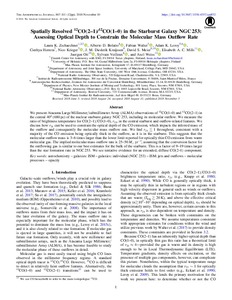Spatially Resolved 12CO(2-1)/12CO(1-0) in the Starburst Galaxy NGC 253: Assessing Optical Depth to Constrain the Molecular Mass Outflow Rate
Zschaechner Laura K.; Bolatto Alberto D.; Walter Fabian; Leroy Adam K.; Herrera Cinthya; Krieger Nico; Kruijssen J. M. Diederik; Meier David S.; Mills Elisabeth A. C.; Ott Juergen; Veilleux Sylvain; Weiss Axel
https://urn.fi/URN:NBN:fi-fe2021042823965
Tiivistelmä
We present Atacama Large Millimeter/submillimeter Array (ALMA) observations of 12CO(1-0) and 12CO(2-1) in the central 40″ (680 pc) of the nuclear starburst galaxy NGC 253, including its molecular outflow. We measure the ratio of brightness temperature for CO(2-1)/CO(1-0), r 21, in the central starburst and outflow-related features. We discuss how r 21 can be used to constrain the optical depth of the CO emission, which impacts the inferred mass of the outflow and consequently the molecular mass outflow rate. We find r 21 ≲ 1 throughout, consistent with a majority of the CO emission being optically thick in the outflow, as it is in the starburst. This suggests that the molecular outflow mass is 3-6 times larger than the lower limit reported for optically thin CO emission from warm molecular gas. The implied molecular mass outflow rate is 25-50 M ☉ yr-1, assuming that the conversion factor for the outflowing gas is similar to our best estimates for the bulk of the starburst. This is a factor of 9-19 times larger than the star formation rate in NGC 253. We see tentative evidence for an extended, diffuse CO(2-1) component.
Kokoelmat
- Rinnakkaistallenteet [27094]
